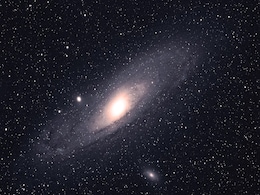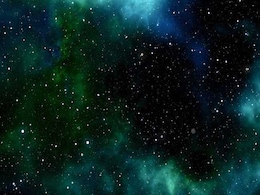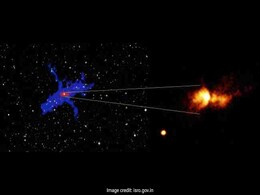Astrosat Telescope
- All
- News
-

ISRO’s AstroSat Observes First-Ever Nuclear Explosion in Andromeda Galaxy
- Tuesday December 10, 2024
- Written by Gadgets 360 Staff
Using the Ultraviolet Imaging Telescope (UVIT) aboard ISRO’s AstroSat, scientists have identified far-ultraviolet emissions from 42 novae in the Andromeda Galaxy. This marks the first detection of such emissions during their outbursts, offering new insights into the processes of stellar explosions. Four of these novae were observed in real-time a...
-
 www.gadgets360.com
www.gadgets360.com
-

ISRO's Space Telescope Spots Over 600 Gamma-Ray Bursts Over 8 Years
- Tuesday November 28, 2023
- India News | Press Trust of India
India's AstroSat space telescope has achieved a significant milestone by detecting more than 600 Gamma-Ray Burst (GRB), each marking the death of a massive star or merging of neutron stars.
-
 www.ndtv.com
www.ndtv.com
-

"Most Spectacular Object": ISRO Discovers "Wings" On Butterfly Nebula
- Thursday November 1, 2018
- Science | Edited by Revathi Hariharan
Indian astrophysicists were treated to what they called the "most spectacular objects in the sky" when they discovered ultraviolet wings around the Butterfly Nebula, captured using Ultraviolet Imaging Telescope (UVIT) of AstroSat. A nebula is an interstellar cloud of dust, and gases.
-
 www.ndtv.com
www.ndtv.com
-

India's First Dedicated Space Observatory Ready to Soar
- Sunday September 27, 2015
- India News | Press Trust of India
If all goes well, India will be the first country in the developing world to have its very own telescope in space.
-
 www.ndtv.com
www.ndtv.com
-

ISRO’s AstroSat Observes First-Ever Nuclear Explosion in Andromeda Galaxy
- Tuesday December 10, 2024
- Written by Gadgets 360 Staff
Using the Ultraviolet Imaging Telescope (UVIT) aboard ISRO’s AstroSat, scientists have identified far-ultraviolet emissions from 42 novae in the Andromeda Galaxy. This marks the first detection of such emissions during their outbursts, offering new insights into the processes of stellar explosions. Four of these novae were observed in real-time a...
-
 www.gadgets360.com
www.gadgets360.com
-

ISRO's Space Telescope Spots Over 600 Gamma-Ray Bursts Over 8 Years
- Tuesday November 28, 2023
- India News | Press Trust of India
India's AstroSat space telescope has achieved a significant milestone by detecting more than 600 Gamma-Ray Burst (GRB), each marking the death of a massive star or merging of neutron stars.
-
 www.ndtv.com
www.ndtv.com
-

"Most Spectacular Object": ISRO Discovers "Wings" On Butterfly Nebula
- Thursday November 1, 2018
- Science | Edited by Revathi Hariharan
Indian astrophysicists were treated to what they called the "most spectacular objects in the sky" when they discovered ultraviolet wings around the Butterfly Nebula, captured using Ultraviolet Imaging Telescope (UVIT) of AstroSat. A nebula is an interstellar cloud of dust, and gases.
-
 www.ndtv.com
www.ndtv.com
-

India's First Dedicated Space Observatory Ready to Soar
- Sunday September 27, 2015
- India News | Press Trust of India
If all goes well, India will be the first country in the developing world to have its very own telescope in space.
-
 www.ndtv.com
www.ndtv.com





